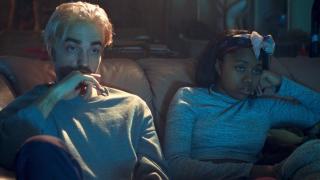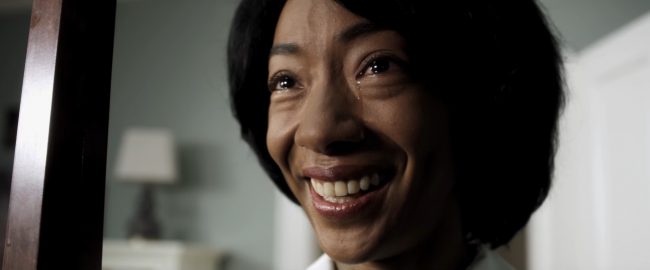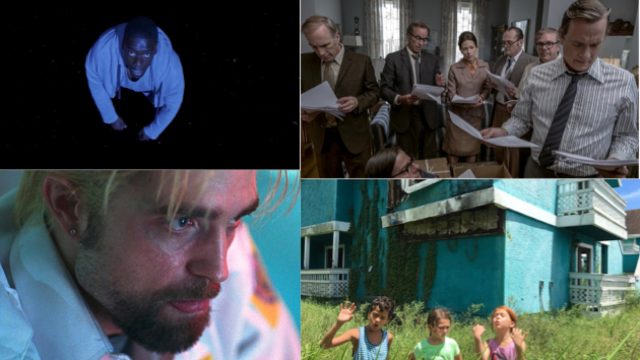Last year, I focused on films that were the coming attractions of the Trump regime. We are now watching the first feature presentation—which can be considered as four films, Good Time, Get Out, The Post, and The Florida Project, that, individually and collectively, imagine the meanings of politics as an ongoing process of interpretation. That is, these films don’t tell us about the current situation; they show us the reality of our daily lived experiences. And that’s a crucial difference.
Some, however, don’t see or appreciate this difference. Which is why, to little surprise, an article like this one (located behind a paywall) arrives, like clockwork, bemoaning how the art of films is lost when their political contexts are taken seriously. It’s an argument that’s been made over and over again, but always with the excitement that it’s somehow being made for the first time. In fact, this argument derives from the literary tradition called New Criticism (you can look it up, really).
What’s being ignored, in any case, is that separating art from politics in films sets up a false dichotomy. It overlooks that neither the production or reception of films is done in a cultural void. Rather, it’s how films play with the tension of the times that counts for a great deal.
Good Time, Get Out, The Post, and The Florida Project all are exceptional instances of this type of play that gives us the thrills of high-wire artistry, while resisting how the complexity of the political moment is too often boiled down to a statement that conveniently fits on an index card. These films challenge us, at times in an uncomfortable way, to think about how we observe the world based on our own expectations—some we may not even be aware that we have.
I. Entrapment and Freedom
Right down to its sardonic title, Good Time evokes the hard-boiled attitude of 70s films about the havoc wrought by white male antiheroes. But rather than revisit the existential crisis that serves as the narrative fulcrum for these films, Good Time draws on the rapid-fire, sensationalistic images of reality TV to dramatize the ineptitude of Connie Nikas, a small-time hood, who schemes to rob a bank with the help of Nick, his developmentally-challenged brother.
The heist takes place. Connie gets away; Nick is arrested and sent to prison. With limited resources, Connie spends a restless night in the borough of Queens, a world away from the gentrified enclave of Manhattan (where Nick receives therapy), on the run from the police.
The directors, Bennie and Josh Safdie, mine Connie’s desperation for comedy. In a screwball twist, Connie tries to rescue Nick from the hospital, after his being brutally beaten by the prison inmates, but ends up, in a case of mistaken identity, getting the wrong guy out, which typifies how every one of Connie’s bad decisions backfires in an even worse way.
 Yet more serious incidents are treated with a similar bemusement. Connie seduces a teenage black girl and then has her drive him around for part of his misadventures, abandoning her when she is arrested for being in the wrong place at the wrong time. He also beats up and drugs a black security guard, leaving him for the police to find—who will then take him in for acting incoherent.
Yet more serious incidents are treated with a similar bemusement. Connie seduces a teenage black girl and then has her drive him around for part of his misadventures, abandoning her when she is arrested for being in the wrong place at the wrong time. He also beats up and drugs a black security guard, leaving him for the police to find—who will then take him in for acting incoherent.
The critical point is that Connie, whether or not intentionally, profits of a system that acts exactly as it’s designed: to expose some—and not others—to greater degrees of risk and liability. White privilege hides in plain sight as a disturbing form of narrative ambiguity about Connie’s decisions that traps us in its circular logic: no matter what perspective we could take, we can’t escape from reaffirming the film’s acidic take on the world.
Get Out has a similarly provocative title—taken from the Eddie Murphy joke (told in his concert film, Delirious [1983]) that it’d be difficult to create a horror movie starring black people, because they’d have sense enough to leave a house the moment they heard a strange voice telling them, “Get out!” Writer and director Jordan Peele plays on the tension when Chris, the young black male protagonist, is taken home by Rose, his white girlfriend, to meet her family for the first time. Chris’s experience, however, becomes a horrific reenactment of the trauma of slavery.
 Peele draws on a complex iconography of political/racial coding, horror movies, and the history of cultural appropriation by white people. Rose’s father enthusiastically tells Chris he’s a diehard Obama supporter. Chris can’t figure out why the black servants act like the robotic women in The Stepford Wives (1975). Rose’s brother plays a ukulele (a musical instrument of Hawaiian culture) and carries a lacrosse stick (a sport of Native American culture).
Peele draws on a complex iconography of political/racial coding, horror movies, and the history of cultural appropriation by white people. Rose’s father enthusiastically tells Chris he’s a diehard Obama supporter. Chris can’t figure out why the black servants act like the robotic women in The Stepford Wives (1975). Rose’s brother plays a ukulele (a musical instrument of Hawaiian culture) and carries a lacrosse stick (a sport of Native American culture).
A family-hosted party is a ruse for Chris’s being auctioned off to the highest bidder. That person, in a mental transference, carried out by Rose’s father (a brain surgeon turned into a mad scientist), will take over Chris’s body. Chris’s consciousness will be cast into the Sunken Place, a memorable image of how the weight of American history presses down, in profoundly unequal ways, on black and white lives.
That nothing is precisely explained—a horror movie tradition—carries a sting when Get Out doesn’t directly answer why black lives are being exploited in this terrifying way. Of course, the critical point is that the film doesn’t have to; it only has to chronicle the obsession of Chris’s friend, a TSA officer, with the failure of interest in the mysterious disappearances of black people.
Chris, in order to escape, has to kill all of the family members, including Rose. Running away from the burning house, which means that all of the evidence will be destroyed, he encounters a patrol car. He put his hands up. Chris’s friend gets out of the car.
We don’t get what we expect: for Chris to be arrested on suspicion of murder. Peele had thought about the ending, and decided to insert a challenging twist. It’s a crucial decision, allowing us to critically examine our own expectations about the legal treatment of young black men. And in this examination, we can ask ourselves what we will, and will not, accept when it comes to the legal system and race. Perhaps, this moment of questioning leads to a moment of intellectual freedom.
II. Historical Connections and Gatekeeping
Although giving audiences what they expect has long been a guiding principle of Steven Spielberg’s film making, The Post has an unexpected intensity in how it argues that the 1971 story about the Pentagon Papers in The Washington Post critically changed our perspective of national leaders. In the opening scene, the expression on the face of Daniel Ellsberg, a military analyst, when he hears his boss lying to the press about the progress being made in the Vietnam war, after Ellsberg told him that the outlook was dismal, shows he’s just about had it. He photocopies the confidential papers that expose the systematic and historical pattern of misinformation, disseminated by the government (going back to President Harry S. Truman), about the military’s involvement in Vietnam.
After a sample of the documents is delivered to The Washington Post by someone working with Ellsberg, a frantic quest is undertaken to contact him before anyone else does. But this adventure is less of the film’s focus. Rather it’s on the internal decision making within the newspaper.
If you’re not paying attention, much of the film will look like a bunch of predominantly white men, in fashionably bad 70s office attire, standing or sitting (or, even, running) around talking, and you’ll miss the film’s careful eye for the body language of power. Katherine Graham is an outsider, having taken ownership of The Washington Post after her husband’s suicide, to the newspaper world. In meetings, she attempts to defend her space, as she spars with editor Ben Bradlee, who thinks the paper should challenge, when necessary, the status quo, and investors, who think the paper should not.
While the deliberations about whether or not to publish the story continue, people at the newspaper read through the massive pile of documents. They are completely shocked by what they find—creating an ethical imperative to inform the public that Graham realizes, as she comes to terms with her husband’s death, must override her loyalty to her political circle of friends.
The crucial point is that the decision to publish was a huge gamble: the outcome, of course, could not be calculated in advance. Graham was warned about the legal repercussions—President Richard Nixon threatened to jail anyone who’d authorize the publication—and the damaging of the paper’s reputation that could lead to bankruptcy. What did result was Nixon’s signing off on a series of illegal operations against those he regarded as his enemies, including (but not shown in the film) the breaking into the office of Ellsberg’s therapist for any evidence that could be used to discredit his leaking of the Pentagon Papers.
The Post ends with a brief scene of the most famous illegal act, the 1972 burglary of the Democratic party headquarters in the Watergate building, the discovery of Nixon’s cover-up of the crime forcing him to resign. While referencing All the President’s Men (1976), about reporters at the same newspaper putting together the Watergate story, it reminds us that historical events are always connected. It’s a welcome corrective to the tendency of films to pretend that the historical event that they portray is the most significant one.
While the White House casts a long shadow in The Post, the gates of Disney World serve a similar purpose in The Florida Project. Director and co-writer Sean Baker takes the familiar narrative device of a world seen through the eyes of Moonee and her friends, but gives these kids the anarchic energy of the three men in Husbands (1970), written, directed, and acted in by John Cassavetes (Baker is an outspoken Cassavetes fan: he has a framed poster of Husbands in his office). Like Husbands, The Florida Project creates a quasi-documentary storyline much looser than Hollywood conventions would require and refuses to glamorize the struggles of its characters. Unlike Husbands, The Florida Project is not focused on middle-class suburbia; rather it’s about impoverished lives just beyond the boundaries of that famous Florida tourist attraction.
Much depends on how poverty is observed. On the one hand, the film reminds us that people don’t always see themselves as poor, especially children. On the other, fantasies of upward mobility are projected on and by the Disney media conglomerate. The film’s central setting, where Moonee and her mother live, is the Magic Palace, a tacky motel, that trades on these fantasies. Yet filmed from certain angles, the building is beautiful in its sheer improbability.
Economic anxiety produces a constant state of crisis. Minor scams are a way of life: the staff at the Magic Palace tricks unwary tourists into staying there, while arranging for long-term residents, who can’t afford to live anywhere else, to have temporary stays elsewhere (to steer clear of legal restrictions). When the kids’ misbehavior results in the burning of an abandoned townhome, people gather around to take in the spectacle.
 There’s the question of how long the kids’ relative innocence will last—and the film does not back away from addressing the complexity of this question (putting to rest at once any accusations that Baker is trafficking in poverty porn). Our empathy is reinforced by being able to see what the children can’t, which shapes the powerful final act.
There’s the question of how long the kids’ relative innocence will last—and the film does not back away from addressing the complexity of this question (putting to rest at once any accusations that Baker is trafficking in poverty porn). Our empathy is reinforced by being able to see what the children can’t, which shapes the powerful final act.
To take care of Moonee, her mother must resort to prostitution—of which we gradually become aware, setting into motion a chain of events that culminates in child welfare workers arranging for her to live with a foster family. She runs away to find a friend. We then see a blurry image of the crowd and surroundings inside the gates of Disney World. The film dissolves into a dream, the only way the kids can experience this moment.
Good Time, Get Out, The Post, and The Florida Project all have much to show us about how those who make the images that enthrall us have the option of redrawing the boundaries between what is, and is not, possible to see. The boundaries may be imposing, such as the gates that regulate entry into Disney World, but they’re constructed by a political ideology that can turn walls into bridges.



